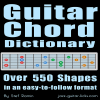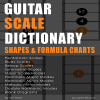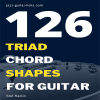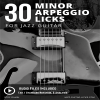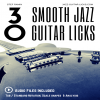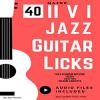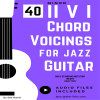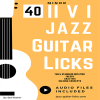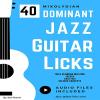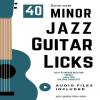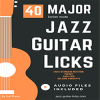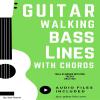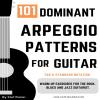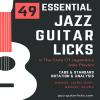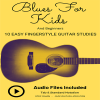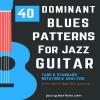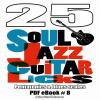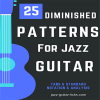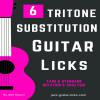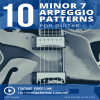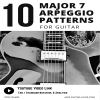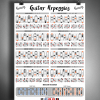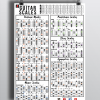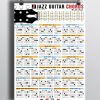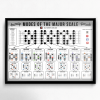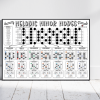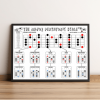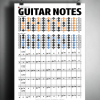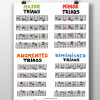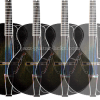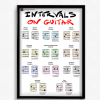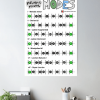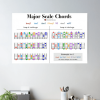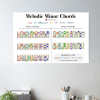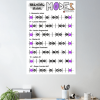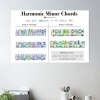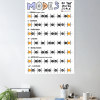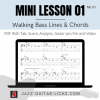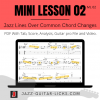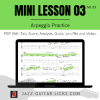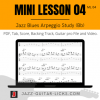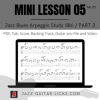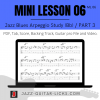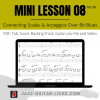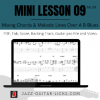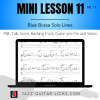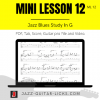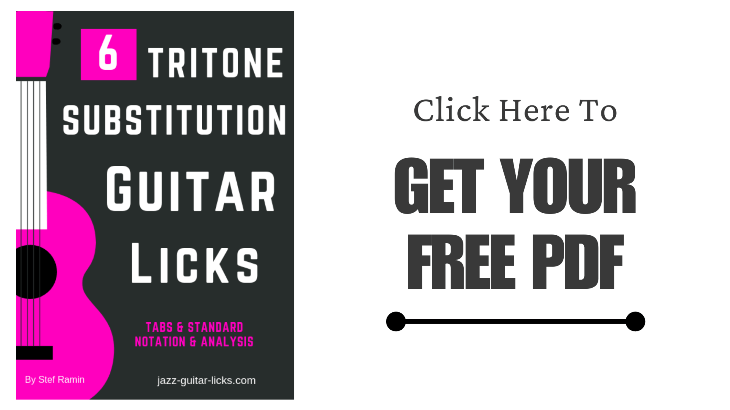6/9 Chords aka 6add9 | Guitar Diagrams and Voicing Charts
The 6/9 chord is a rich, colorful chord often used in jazz, bossa nova, funk, and soul.
It adds warmth and smoothness compared to a regular major chord.
Built on a major triad (root, 3rd, 5th), it extends the harmony by adding the 6th and the 9th degrees of the scale.
Construction
A 6/9 chord, also known as a "six-nine" chord, is a musical chord that includes the following notes: the root, third, fifth, sixth, and ninth.
In terms of intervals, this chord consists of a major triad (root, major third, and perfect fifth) with the added sixth and ninth.
- root (1),
- major third (3)
- perfect fifth (5)
- sixth (6)
- ninth (9)
6/9 voicings are very cool because they have a somewhat more interesting, ambiguous and rich sound.
They are great for substituting major chords.
This type of chord also can embody a fourth-stack.
For example, with C6/9, we got C in the bass and three notes stacked in fourth from the third of C (EAD) giving a C6/9 chord.
Chord Symbols and Notation
6/9 chords can be written 6-9, 69, 6/9 or 6add9.
Differences Between maj6, maj13, maj9 and 6/9 Chords
Some type of chords can be confusing.
Here is a summary chart :
- maj6 chords are built with 1 3 5 6
- maj13 chords are built with 1 3 5 7 9 11 13
- maj7add13 are built with 1 3 5 7 13
- maj9 are built with 1 3 5 7 9
- 6/9 chords are built with 1 3 5 6 9
| Cmaj6 | C | E | G | A | |||
| Interval Pattern | 1 | 3 | 5 | 6 | |||
| Cmaj13 | C | E | G | B | D | F | A |
| Interval Pattern | 1 | 3 | 5 | 7 | 9 | 11 | 13 |
| Cmaj7add13 | C | E | G | B | A | ||
| Intervale Pattern | 1 | 3 | 5 | 7 | 13 | ||
| Cmaj9 | C | E | G | B | D | ||
| Interval Pattern | 1 | 3 | 5 | 7 | 9 | ||
| C 6/9 | C | E | G | A | D | ||
| Interval Pattern | 1 | 3 | 5 | 6 | 9 |
Comparison With m11 Chords
As you can see that 6/9 chords are built with a root (R) and four notes stacked in fourths (3,6,9 and 5).
Starting from the major third of a 6/9 chord, you get a m11 chord.
This chart below shows the relationship between C 6/9 and Em11.
| C6/9 | C | E | A | D | G |
| Intervals | 1 | 3 | 6 | 9 | 5 |
| Em11 | E | A | D | G | |
| Intervals | 1 | 4 (11) | b7 | b3 |
How to Use 6/9 Chords?
Here are two 69 chord applications. In this first II-V-I in C major, we will use three chords.
- Dm11 with no root (rootless).
- G13 with no root.
- C69 with no root. If you have read right the previous explanations, this chord can be considered as Em11.
So the original progression which was Dm7 | G7 | Cmaj7 has become Dm11 | G13 | C69
In this example, G7 is replaced by G6. Then two chords, C6/9 and Cmaj6 are played instead of Cmaj7.
-
Guitar Chord Dictionary
This PDF eBook provides over 550 guitar chord shapes. This is the perfect reference guide to understand how chords are built and how to play them on the guitar neck. -
Guitar Scale Dictionary
This E-book is a printable PDF method including over 700 scale diagrams and formula charts for guitarists. -
Harmonized Scales For Guitar
Complete guitar PDF on harmonized scales: major, minor, harmonic and melodic. Includes chord and arpeggio diagrams, charts and practical tabs. -
172 Arpeggio Shapes For Guitar
This printable PDF is a method dedicated to guitarists of all styles who want to learn build and play the most important types of arpeggios. -
126 Triad Chord Shapes
This handbook for guitar players is intended both for teachers and students. It includes 126 guitar shapes for mastering triads. -
Harmonic Major Scale Chords
this PDF offers diagrams and tabs for guitar to learn the chords of the harmonic major scale. -
Major Scale Harmonization
This package provides a printable PDF with exercises and audio files to learn how to harmonize the major scale with 3 note chords and their extensions. -
30 Minor Arpeggio Licks
This package includes a printable PDF method containing 30 exercises with tabs, staves and audio files for practicing minor arpeggios on guitar. -
II V I Bundle - 170 Exercises
This bundle contains 4 PDF methods for a total of 170 exercises with tabs, staves, analysis & audio files for practicing scales, arpeggios licks & chords over the 2-5-1 progression. -
Diatonic Licks Bundle
This package contains 120 jazz guitar lines based on diatonic modes as Mixolydian, Dorian and Ionian. PDF format with tabs, audio files and analysis. -
30 Groovy Jazz Guitar Licks
This downloadable package contains a PDF WITH audio files giving access to 30 groovy guitar phrases mixing jazz, blues and funky licks for beginners. -
30 Smooth Jazz Guitar Licks
In this package you'll get a printable PDF Method with tabs, notation, analysis, scale shapes and audio files for practicing 30 smooth jazz guitar licks. -
40 II V I Jazz Guitar Licks
This pdf method for guitar contains fourteen 2 5 1 jazz guitar lines with tab, standard notation, analysis, scale charts and audio files. -
50 II-V-I voicings
This printable PDF guitar method provides 50 exercises with audio files, analysis, tab and staves for learning major 2-5-1 chord voicings. -
40 Minor 2 5 1 Chord Voicings
This PDF method contains 40 exercices with tabs, scores and audio files for practicing jazz guitar chords over the minor 2 5 1 progression. -
40 Minor II V I Licks
This guitar method is a printable PDF with tabs, diagrams, theory and audio files providing 40 minor 2 5 1 jazz patterns. -
40 Mixolydian Jazz Guitar Lick
PDF guitar method with tabs, audio files and theory providing 40 dominant jazz guitar lines for teachers and students. -
40 Minor Jazz Guitar Licks
This printable guitar method in PDF format contains 40 easy minor jazz guitar lines based on the Dorian mode. -
40 Major Jazz Guitar Licks
Printable PDF eBook method containing 40 major jazz guitar licks with tab, standard notation and audio files for beginners and intermediates. -
Guitar Walking Bass Lines
This jazz guitar method about walking bass lines and chords is available as a PDF files containing 35 exercises with tabs, analysis and audio files -
101 Dominant Arpeggio Patterns
This printable PDF method provides 101 dominant arpeggio exercises with tab, theory and standard notation for the jazz, blues and rock guitarist. -
49 Essential Jazz Lines
This printable eBook method in PDF format provides 49 jazz solo transcriptions of the greatest jazz musicians. Tab, standard notation, audio files & analysis. -
11 Jazz Blues Studies
11 jazz blues chord studies with tabs, standard notation, analysis, and audio recordings and PDF. -
10 Easy Fingerstyle Blues
This PDF with Tabs and audio files provides 10 easy acoustic fingerstyle blues guitar studies for kids and beginners. -
25 Altered Jazz Guitar Lines
This PDF eBook method contains 25 altered jazz guitar licks with tabs, patterns, scale charts and audio files to master, apply and develop the altered scale. -
40 Blues Dominant Patterns
This printable method is available as a PDF file containing 40 easy dominant jazz-blues guitar lines with tabs, standard notation, analysis, audio files and scale charts. -
25 Pentatonic Licks
This jazz guitar method is an eBook available as a PDF with standard notation, guitar tabs, diagrams, analysis, audio files and backing tracks. You will find in this booklet 25 easy jazz guitar lines with theory using common and rare pentatonic scales. -
25 Soul Jazz Guitar Licks
You will find here an eBook available in PDF containing 25 soul jazz and hard bop guitar licks in the style of Grant Green, Melvin Sparks, George Benson. -
25 Diminished Patterns
This eBook PDF with audio files contains 25 dominant diminished jazz guitar patterns using the half-whole diminished scale and diminished 7th arpeggios. -
6 Tritone substitution licks
This Printable PDF eBook available for free download contains 6 easy jazz guitar licks with tabs/notation, youtube video link and analysis about the tritone substitution. -
10 Minor 7 Arpeggio Patterns
This printable PDF eBook offers 10 easy minor 7 arpeggio patterns with its related YouTube video for beginner guitarists. -
10 Easy Major 7 Arpeggio Licks
This is a printable PDF for beginner jazz guitar players providing 10 easy licks to practice major 7 arpeggios. -
10 Chord Melody Lines
Within this package, you'll discover a set of ten chord melody exercises for beginners. Printable PDFaudio files, a backing track, and a link to the associated YouTube video. -
10 Minor Blues Scale Licks
You'll find here a PDF with 10 easy jazz guitar licks to practice the minor blues scale on guitar.
-
Guitar Arpeggios Poster
This giant guitar poster for any guitar player, student or instructor contains colorful arpeggio diagrams. Giant size 24 x 36 inches (60 x 90 cm). -
Guitar Scales Poster 24*36
Guitar posters and wall art with eighteen neck diagrams representing the most used scales in music. -
Guitar Chord Poster
This printed color posters contains 63 guitar chord diagrams for jazz players, students, teachers and schools. -
Guitar Modes Poster
Guitar reference posters and wall art about modes of the major scale for guitar teachers, students and music schools. -
Melodic Minor Modes Poster
Educative and decorative giant guitar poster with neck diagrams, interval names about the seven modes of the melodic minor scale. -
Pentatonic Scale Guitar Poster
This guitar reference poster shows the positions and intervals of the major pentatonic scale. -
Guitar Notes Poster
This is a giant poster showing the notes on the guitar fret board and their positions on a musical staff. -
Triads Guitar Poster
This reference poster show the positions and intervals of the main triads used on guitar. This is a useful tool for guitarists, teacher and students. -
Four Archtop Guitars Poster
This is a decorative poster with four archtop jazz guitars. Several size and colors in landscape format available on Teespring and redbubble. -
Intervals On Guitar - Poster
This giant poster for guitar provides neck diagrams with interval positions. -
Melodic Minor Modes
This music theory poster available in several sizes shows the construction of the seven modes of the melodic minor scale. -
Major Scale Chords
This handy poster provides a clear visual guide to the chords built from the major scale, helping you recognize patterns and improve your playing. -
Melodic Minor Chords
Explore the rich harmonic possibilities of the melodic minor scale with this essential guitar poster. -
Harmonic Minor Modes
This music theory poster, offered in various sizes, demonstrates the structure of the seven modes of the melodic minor scale. -
Harmonic Minor Chords
Discover the chords of the harmonic minor scale with this guitar poster. -
Major Scale Modes
This poster is created for music teachers and students, illustrating the structure of the seven modes of the major scale.
-
Mini Lesson 01 (ML 01)
You'll find a mini guitar lesson about walking bass lines and chords containing a PDF with tab, score analysis, shapes, a video and a guitar pro file. -
Mini Lesson 02 (ML 02)
In this mini jazz guitar lesson you will learn how to play easy and cool jazz lines over basic chord changes found in jazz. Pdf, tab and video included. -
Mini Lesson 03 (ML 03)
With this short lesson you will learn how to play and connect basic guitar arpeggios over a diatonic chord progression. -
Mini Lesson 04 (ML 04)
This is a downloadable package with PDF, Tab, guitar pro file and video to practice guitar arpeggios over a jazz blues chord progression. -
Mini Lesson 05 (ML 05)
This downloadable package provides a PDF with Tab/score, a guitar pro file and a short video for practicing guitar arpeggios on a jazz blues progression in Bb. -
Mini Lesson 06 (ML 06)
This package for guitarists contains a PDF with tab, video, backing track and guitar pro file for practicing arpeggios over a basic jazz blues progression. -
Mini Lesson 07 (ML 07)
With this mini guitar lesson you will learn how to superimpose arpeggios over a diatonic chord progression. Video, pdf, jamtrack and guitar pro file included. -
Mini Lesson 08 (ML08)
Mini lesson with PDF, guitar pro file, video and backing track for practicing scale and arpeggio connections over a Bb jazz blues progression. -
Mini Lesson 09 (ML09)
This mini lesson is a downloadable package containing a PDF, video, backing track and guitar pro file of a jazz blues progression study in B. -
Mini Lesson 10 (ML 10)
This mini guitar lesson provides a printable PDF with tab/notation, video, backing track and guitar pro file for practicing open triads over Fly Me To The Moon. -
Mini Lesson 11 (ML 11)
This guitar lesson is a package inlcuding a PDF transcription with analysis, a short video, a backing track and a guitar pro file to learn to play jazz solo lines over Blue Bossa. -
Jazz Blues Guitar Study (ML12)
This mini lesson provides a video, a guitar pro file and PDF transcription of a jazz blues study in G implying melodic lines, chord extensions and substitutions
Last edited: 2025-08-20
Comments
-

- 1. JazzGuitarFan87 On 2025-08-20
Excellent page ! When should I use a 6/9 chord in a song?-
- jazz-guitar-licksOn 2025-08-20
Hello, You can use a 6/9 chord whenever you want to add a smooth, jazzy, or dreamy sound to a song. They work especially well: As a substitute for a major chord in a chord progression. In jazz, bossa nova, or soul styles where a richer harmony is desired. On the I chord (tonic) or in II–V–I progressions to make the harmony sound more colorful. Basically, anytime you want a chord that’s pleasant, open, and sophisticated without sounding tense, a 6/9 chord is a great choice. Stef
-

- 2. Steve On 2024-01-27
Love these chords, thanks for the lesson.-
- jazz-guitar-licksOn 2024-01-27
My pleasure, thanks for stopping by. Stef
-

- 3. Tim On 2019-08-12
If you're going to use a triangle to denote a major note, that's fine for the 3 and 6, but why not use it also for the 9th?-
- jazz-guitar-licksOn 2019-08-13
Good question, because the 9 is an extension, the octave of the 2nd. This one can be noted 2▲
Add a comment




